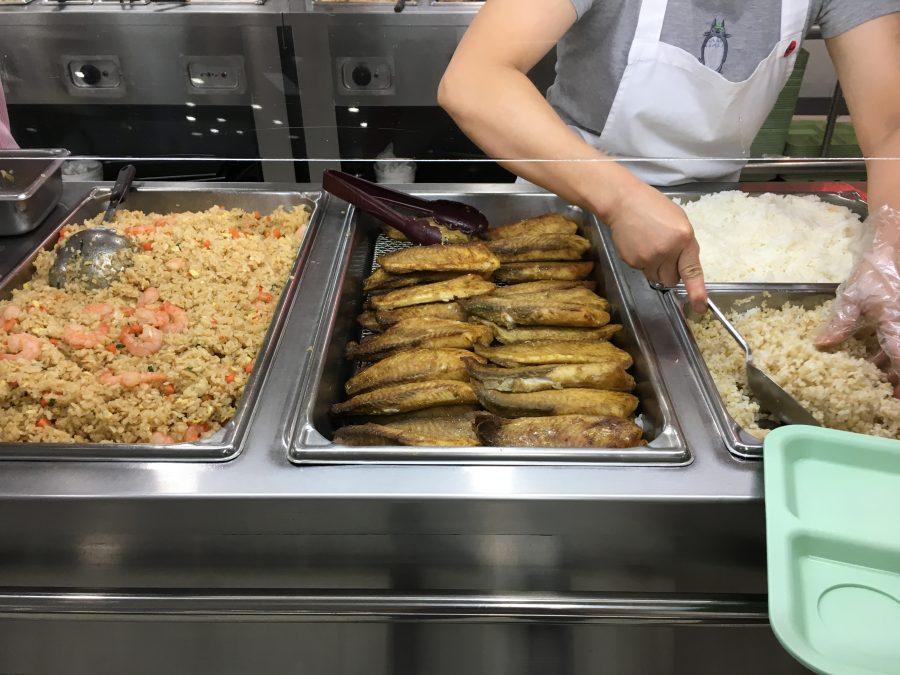Last year, our school disposed of 3.69 tons of food waste and that number has since skyrocketed to 8.93 tons in April of this year. Over the past few years, TAS has been working towards focusing their waste reduction initiative on food waste specifically. Students are conditioned about the harms of food waste but we rarely know what actually happens to the food that is being assembled in the cafeteria every day.
“Once it’s thrown out, they usually get processed before they end up in a dump or as pig feed,” says Jason Wang (12), Vice President of StuGov.
This kind of waste is not the same as the trash we see in the trash cans after lunch. Besides the waste we see in the trash cans of the cafeteria everyday, there is a different kind of trash that must be disposed of: raw product waste.
Say, for example, TAS decides to order 20 kilos of carrots but only uses 16 kilos before they go bad. The remaining amount must be tossed out, and this kind of waste is monitored very closely by our Food Services department.
Mr. O’Neal, Director of Food Services, says, “The food that is taken out to the serving lines and put it in the warmer wells everyday, whatever is left from there, our employees eat for lunch and whatever is left from there gets thrown out. We can’t have leftover food from the serving line out there re-served the next day.”
If the food has already been assembled, it will be eaten either by students, employees, or thrown away as trash. However, as long as something has not yet been put together and can be frozen, it can be stored away and used as spare for a separate date.
The waste that the cafeteria is tracking would never be discussed in kilos because that does not really give them any solid information about how they are doing sales-wise. Instead, the amount must be expressed as a percentage.
Mr. O’Neal says, “Normally what we do is we look at the dollar value of the items that are thrown out, and we look at what percentage of sales that accounts for and that basically determines whether that amount we throw out is reasonable or not. For example, finished product waste can definitely be no more than 1% of the amount of food sold. Raw product waste is somewhere between the zone of 0.5% and 0.7%.”
According to Mr. O’Neal, our cafeteria cooks in batches, meaning they will not make 400 taco salads all in one round, but will cook based on how many people they predict will come in.
“You can look at the historical data and say well, we sold 200 portions of this and next time around, assuming everyone’s in school, it’ll probably be somewhere around that,” says Mr. O’Neal.
Although students cannot really influence the amount of raw product waste and leftover food TAS ends up throwing, the unfinished food we throw out is dependent on students. It is up to students to stay aware and cautious about the amount of food that they buy and eat.
Jason says, “Some people throw away unfinished food because lunch is over and they don’t have time to finish, so I think a good way to prevent that is to just finish eating before doing anything else.”
Another way StuGov is trying to address this issue is by creating short lessons on food waste based around “The Hungry Caterpillar” for lower schoolers.
“We hope it will be able to instill this sense of being mindful with their food so that it won’t be a problem for them in the future,” says Jason.


![Members of Flourishing Love arrange bouquets together. [PHOTO COURTESY OF FLOURISHING LOVE]](https://blueandgoldonline.org/wp-content/uploads/2023/12/fl-1200x900.jpeg)
![Members of Formosa Charity reconstruct an old home. [PHOTO COURTESY OF CHAEWON B. (25)]](https://blueandgoldonline.org/wp-content/uploads/2023/12/bwb.jpeg)


![Catrina was waitlisted at Caltech but
intends to pursue Computer Engineering
at the University of Washington. [PHOTOS
COURTESY OF CATRINA Y.]](https://blueandgoldonline.org/wp-content/uploads/2023/05/Copy-of-IMG_4544-900x602.jpg)
![Honors Film 3 and 4 students set up the camera and microphone to get ready for an interview. [PHOTO COURTESY OF TAS FILM]](https://blueandgoldonline.org/wp-content/uploads/2023/05/DSC09834-900x507.jpg)